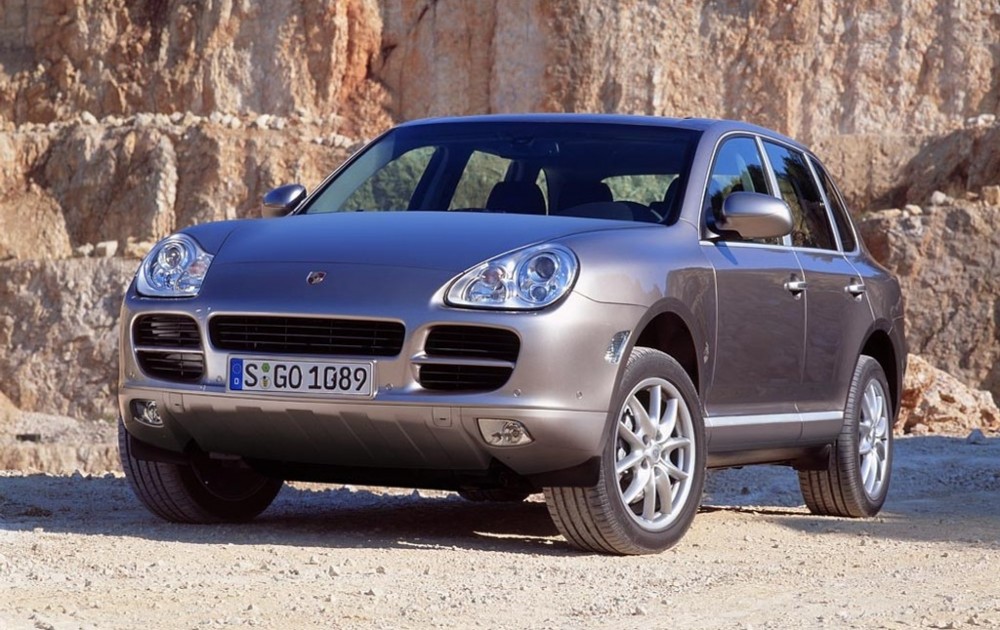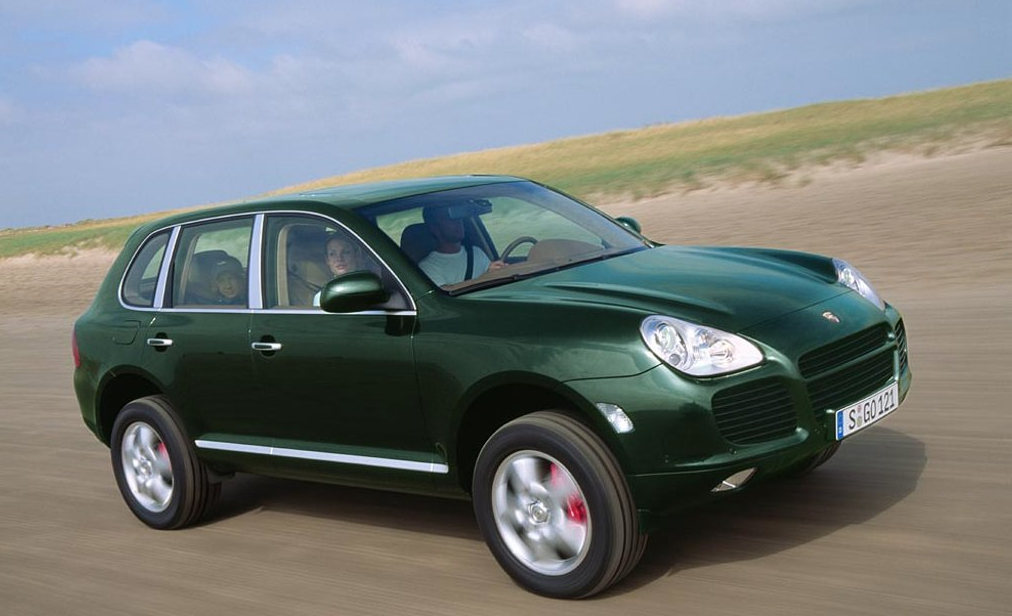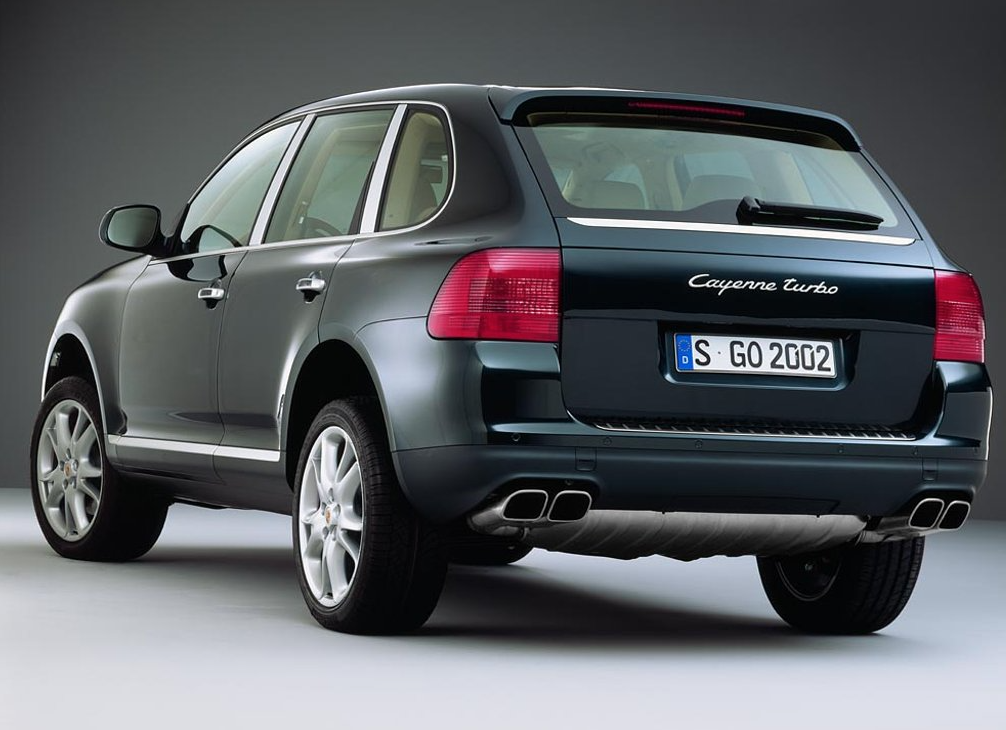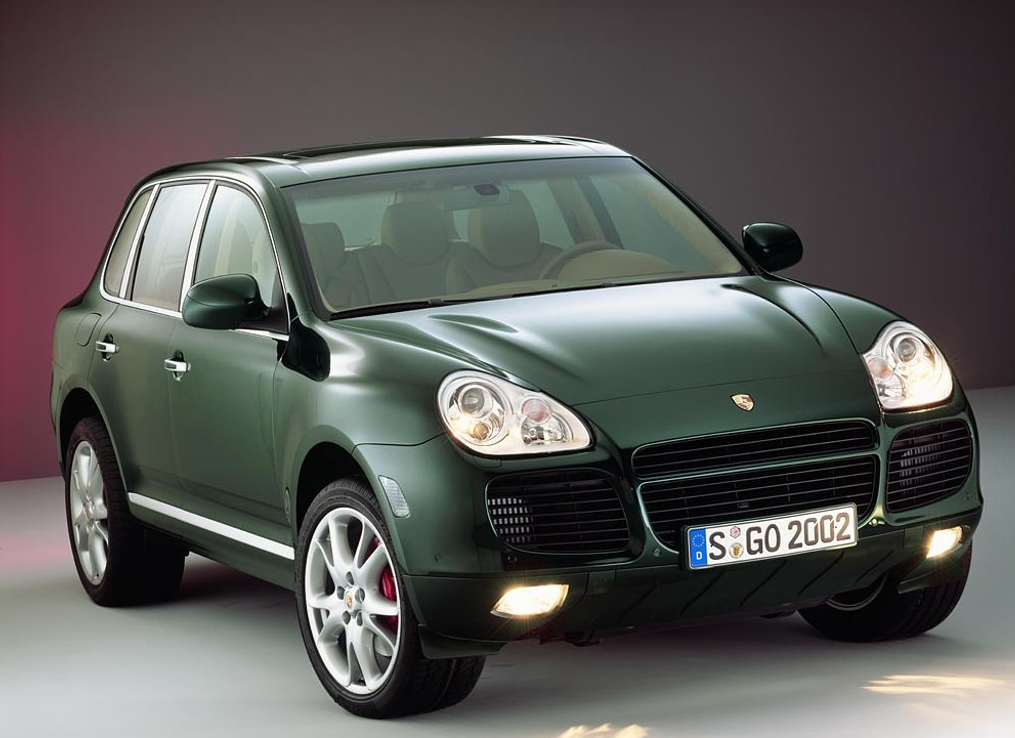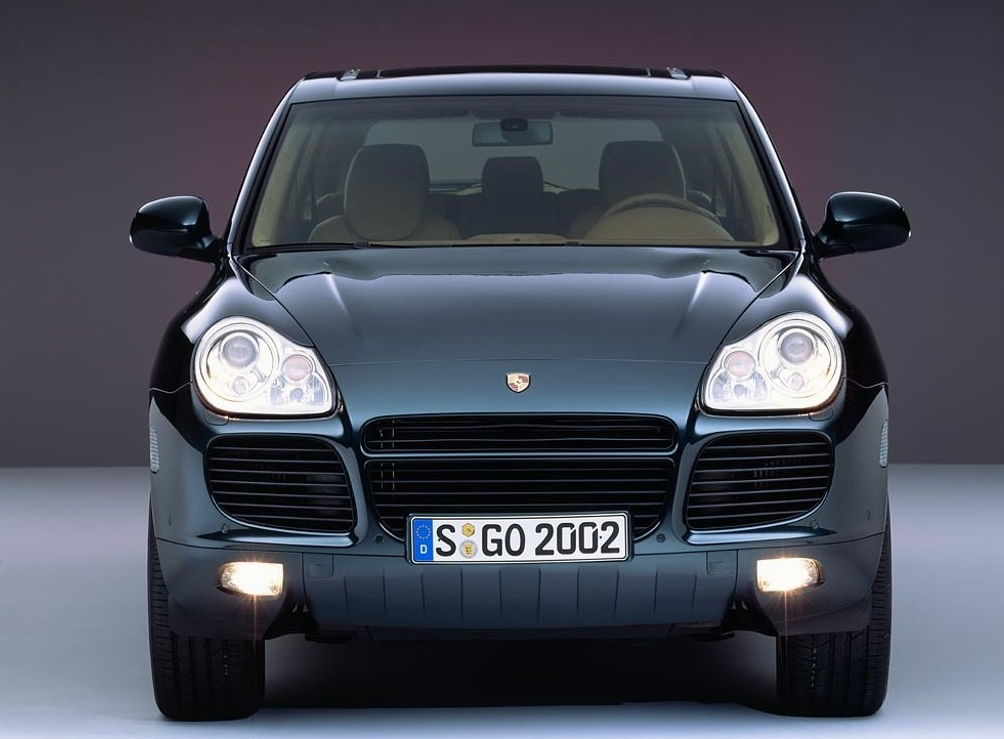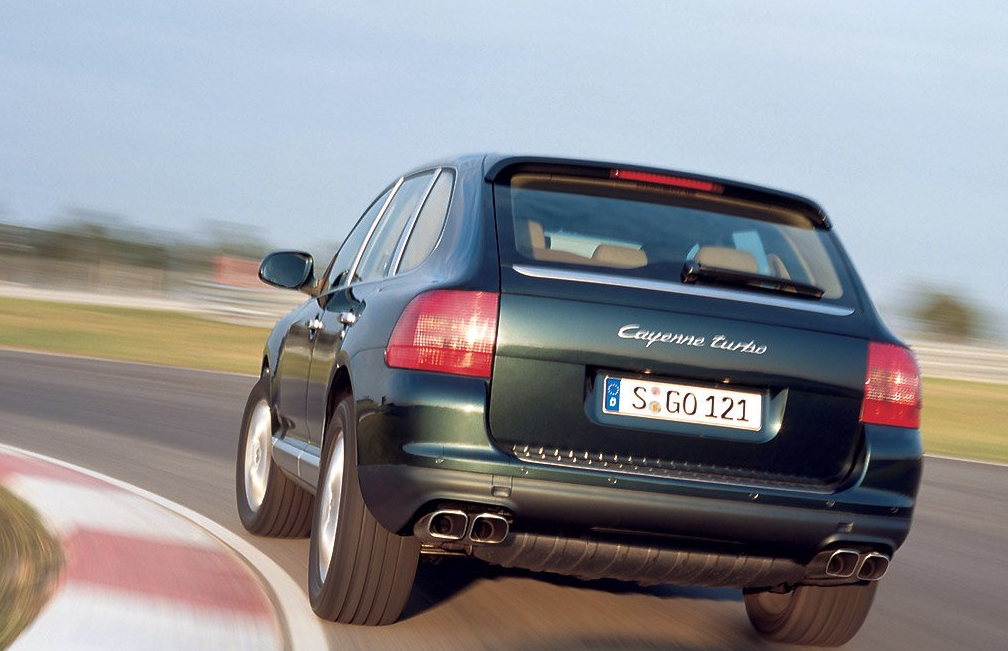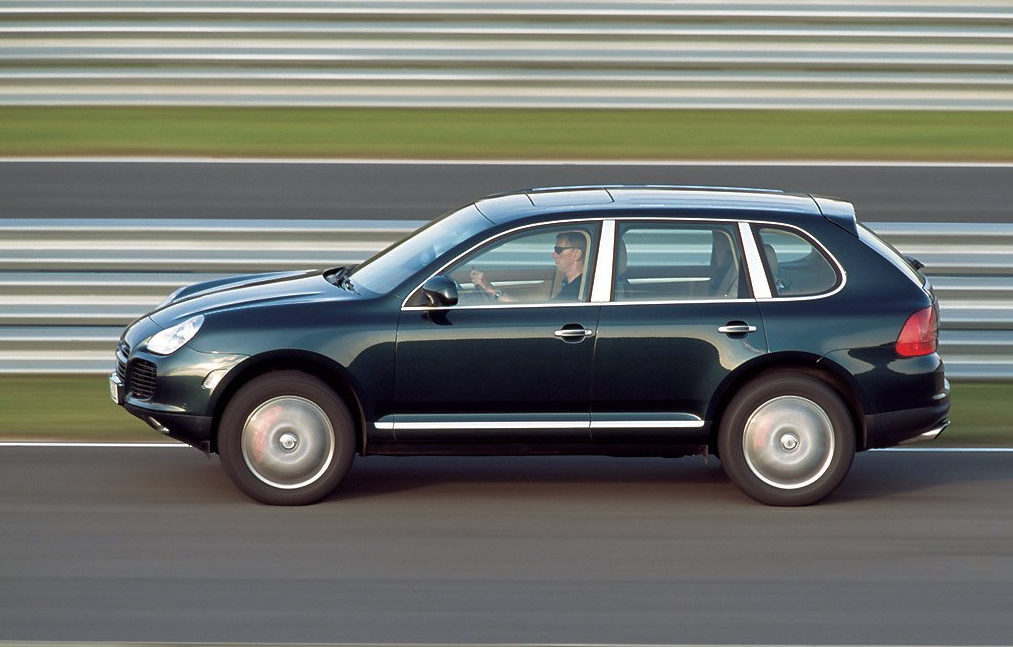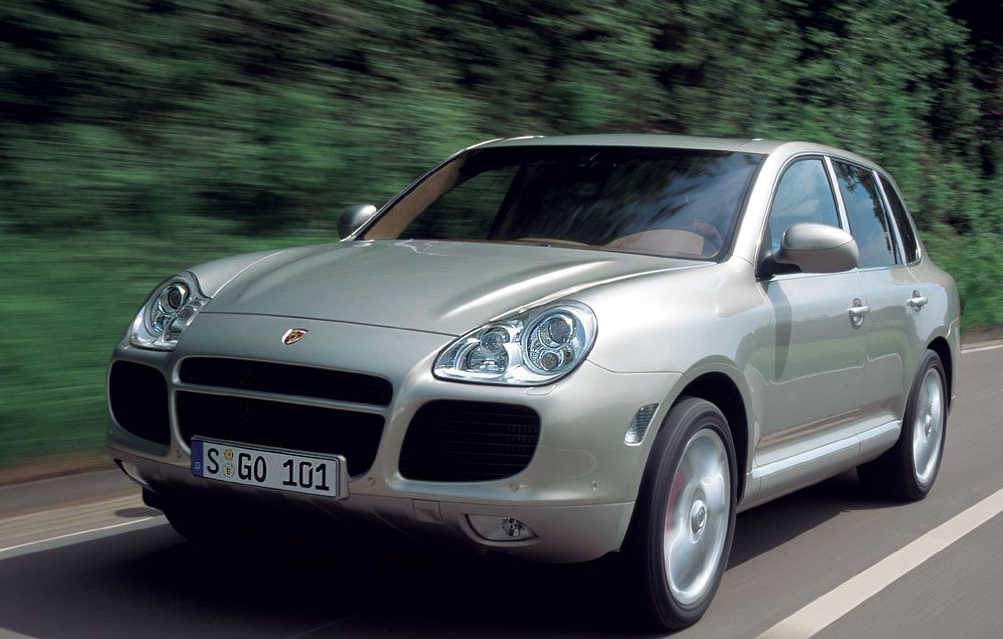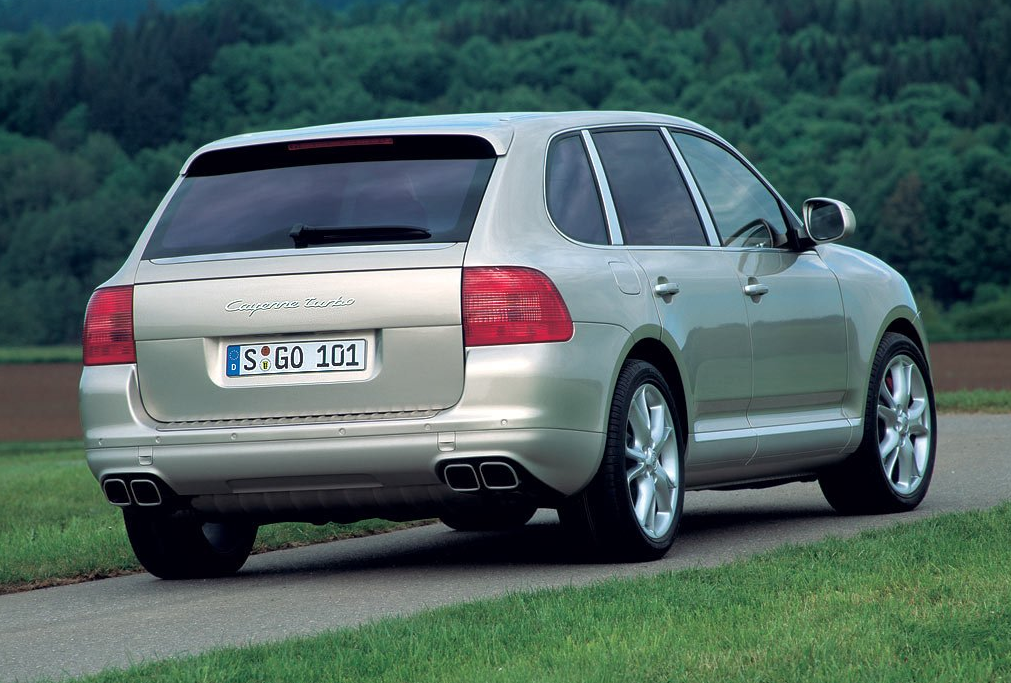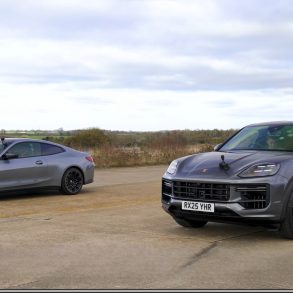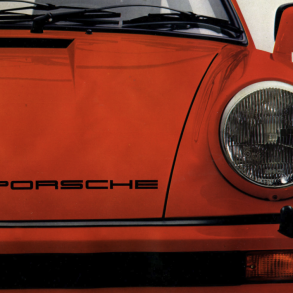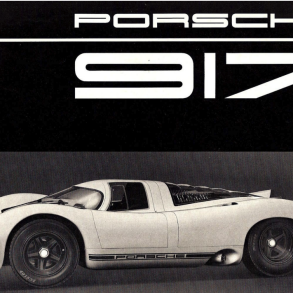(2002 – 2007) Porsche Cayenne Turbo – Ultimate Guide
The first-generation Cayenne Turbo 955 has 450 PS (331 kW), and can accelerate from 0–100 km/h (62 mph) in 5.3 seconds. Under the hood, the Cayenne Turbo was fitted with a turbocharged 4.5-liter V8 unit mated to a standard 6-speed automatic. Thanks to the standard air-suspension, the Turbo version could get up to 28 cm (11”) of ground clearance. It was inconceivable for a Porsche fan to accept an SUV from the famous sports-car manufacturer. But the car was needed. The German brand needed a car to sell in volumes and save them from a foreseeable financial collapse. The Cayenne Turbo managed to satisfy the customers who were looking for a performance vehicle in an SUV shape.
The front bumper was tall and crossed by no less than four grilles, either for the look or to cool the engine. As any SUV on the market, the Cayenne featured a tall greenhouse, which was somehow unusual for the Porsche brand. The Turbo version was designed to be the sportiest version for the medium-sized SUV. In the back, a quad exhaust system was installed and an aluminum shield was seen under the bumper. Inside, the gear-selector was carried-over from 911. The instrument panel featured two large round dials with a central multi-functional display. A tall center console separated the front passengers. The power-adjustable leather front seats were accompanied by the rear leather bench, which featured a split-backseat to extend the trunk space. The Cayenne S featured a Bose sound system with 14 speakers. A Porsche Communication Management (PCM) infotainment unit with navigation and a backup camera was available.
Pictures
Press Release
The Porsche Cayenne demonstrated its on- and off-pavement capabilities during development testing on the twisting, high-speed road racing circuit at Germany’s famed Nürburgring as well as in Arctic snow and ice, in the sun-baked environment of Australia’s Outback, in the sands of Dubai, and on the slick and steep surfaces of North America’s Rocky Mountains. Now the Porsche Cayenne S and Porsche Cayenne Turbo are ready to demonstrate their capabilities in the hands of Porsche customers.
“The Porsche Cayenne is the first vehicle to really put the sport into sport-utility,” says Frederick J. Schwab, president and CEO of Porsche Cars North America. “I know that others have made a similar boast, but we’re confident that the Porsche Cayenne will more than live up to that claim. The Porsche Cayenne may have the architecture of an SUV, but it has the soul that is part of every Porsche product,” Schwab adds.
The Porsche Cayenne takes its name from the one of the very hottest of red peppers, recognized around the world as a symbol for zestful spiciness. With as much as 450 horsepower, with 0-to-62 mph sprint times as quick as 5.6 seconds, and with Porsche Traction Management and other innovative technologies that provide sure-footedness in high-speed lane changes and for crawling up slick rock and down steep and rocky trails, the Porsche Cayenne is the first true sport-utility.
With four doors, luxuriously comfortable seating for five, room for the gear a family needs to enjoy an active lifestyle, and a towing capacity of more than 7,700 pounds, the Porsche Cayenne is the first Porsche to provide such true utility.
Porsche Cayenne S: Very special indeed
As Porsche enthusiasts already know, the “S” badge signifies a truly special Porsche model, not merely a trim upgrade or option package.
The Porsche Cayenne S maintains a tradition that dates to 1952 with the S version of the original Porsche, the 356. Since then, the S badge has been worn by the famed 911S that arrived in 1967 and subsequently by such outstanding vehicles as the Boxster S and the 911 Carrera 4S.
For the launch of the Porsche SUV, the Porsche Cayenne S earns its special designation thanks to its 340-horsepower (SAE), 4.5-liter, normally aspirated V8 engine, a powerplant designed and manufactured by Porsche that ranks the Porsche Cayenne S among the strongest of all sport utilities. It features an all-new, six-speed Tiptronic S transmission and introduces Porsche Traction Management four-wheel-drive technology that provides outstanding performance during maneuvers on a variety of paved and unpaved terrain.
The Porsche Cayenne S carries such standard equipment as Porsche Stability Management; front, side and curtain airbags; a Bose Cabin Surround Sound System; leather upholstery and automatic climate controls.
The Porsche Cayenne S has a base price of $55,900 in the United States and $78,250 in Canada.
Porsche Cayenne Turbo: The ultimate in performance
With twin turbochargers boosting the output of its 4.5-liter V8, the Porsche Cayenne Turbo delivers 450 horsepower and 457 pound-feet of torque, power that propels it from a standing start to 62 mph (100 km/h) in a mere 5.6 seconds and to a top track speed of 165 mph (266 km/h).
But the Porsche Cayenne Turbo is just as capable off-pavement, thanks to its combination of Porsche Traction Management with standard air suspension that can provide nearly 11 inches of ground clearance for traversing rough terrain.
Like the Cayenne S, the Porsche Cayenne Turbo comes with such standard equipment as Porsche Stability Management; a six-speed Tiptronic S transmission; front, side and curtain airbags; full leather upholstery and automatic climate controls. The Porsche Cayenne Turbo adds such features as an aluminum-trimmed interior and the new Porsche Communications Management technology that includes a navigation system and Bose Cabin Surround Sound System.
The Porsche Cayenne Turbo has a base price of in the United States of $88,900 and $125,100 in Canada.
The Porsche Cayenne’s heart is its new Porsche V8 engine
Production plans for the Porsche Cayenne were announced in the summer of 1998, when it was disclosed that the Porsche SUV would have permanent four-wheel drive and genuine off-pavement capabilities, but also would achieve Porsche benchmarks for ride and handling. This Porsche SUV would be built at a new, state-of-the-art assembly center at Leipzig, Germany, where Porsche also has constructed on- and off-pavement testing facilities.
While the Porsche Cayenne would be built on the same platform as a new Volkswagen SUV, Porsche, which would develop new engines to power its SUV, would lead the design and engineering efforts.
The new Porsche V8 is a 4.5-liter unit with 32 valves (two intake and two exhaust valves per cylinder), Porsche’s VarioCam technology, and integral dry sump lubrication. The two banks of cylinders are placed at a 90-degree angle.
The engine is designed to operate smoothly at an angle of 45 degrees off horizontal, thus providing optimum off-pavement abilities. This required modification of the oil circuit and crankcase-venting system, most notably separate oil re-flow ducts leading from the cylinder heads into the oil sump. Separation of the oil circuit from the vent ducts enables engine oil to flow quickly and directly back to the oil sump to maintain a sufficient oil supply at all times. On extreme gradients, an efficient supply of oil is also guaranteed by added oil extraction from the rear section of the oil sump, by the oil intake opening for the main oil pump being lowered right to the bottom point, and by a baffle wall in the oil sump.
The V8 shares much of its internal architecture with the water-cooled six-cylinder engine that was developed to power the Porsche Boxster. However, Porsche engineers developed specific components and dimensions for the Porsche Cayenne’s new V8. For example, while the 3.66-inch (93 mm) cylinder bore is the same as the Boxster’s, the V8 has a longer stroke of 3.27 inches (83 mm).
The V8 has a two-piece cylinder head similar to that developed for the powerful 911 Turbo, and the Porsche Cayenne engine’s cylinder head makes use of an aluminum/silicon alloy that can withstand very high temperatures.
As with all other Porsche models, the new V8 makes use of Porsche’s VarioCam technology. For the Porsche Cayenne’s V8, VarioCam can adjust the camshafts by as much as 25 degrees, ensuring outstanding torque characteristics as well as optimum fuel efficiency and lower emissions.
Engine coolant is distributed to the crankcase and cylinder heads by a distribution pipe located above the transmission. The water pump, mounted at the front of the engine, pumps coolant through a pipe located in the interior of the engine’s V. Approximately 20 percent of the coolant flows through the crankcase in a lengthwise direction with 80 percent flowing through the cylinder heads in a “crossflow” architecture from the hot to the cold side. Heat from the engine oil is fed into the coolant through an oil/water heat exchanger.
Low emissions
The stainless steel exhaust system features an exhaust pipe for each row of cylinders that is connected downstream of the main catalysts by a crossover pipe. This architecture allows enhanced torque at low engine speeds. The pre- and main catalysts are metallic, allowing thinner design of the coated inner walls. This system also provides a larger overall area within the catalyst ducts, ensuring higher efficiency, longer service life and more rapid build-up to the temperatures required for maximum catalyst efficiency.
The catalysts are controlled by two oxygen sensors. This dual-sensor control minimizes exhaust emissions, enabling both the Porsche Cayenne S and the Cayenne Turbo to meet LEV (low emission vehicle) standards in the United States and to fulfill the EU4 standards that go into effect in Europe in 2005.
Porsche Cayenne S rated at 340 horsepower
The normally aspirated engine in the Porsche Cayenne S is rated at 340 horsepower (SAE) and provides 310 pound-feet of torque all the way from 2,500 rpm to 5,500 rpm. Working in conjunction with the new six-speed Tiptronic S transmission, the normally aspirated 4.5-liter V8 propels the Porsche Cayenne S from a standing start to 62 mph (100 km/h) in only 7.2 seconds. The Porsche Cayenne S can achieve a top speed of 150 mph (242 km/h) on the test track.
Turbochargers boost output to 450 horsepower and 460 pound-feet of torque
The Porsche Cayenne Turbo is powered by a similar 4.5-liter V8, but two turbochargers recycle the engine’s exhaust gases and boost its power to a staggering 450 horsepower (SAE) at 6,000 rpm and to a whopping 457 pound-feet of torque throughout the 2,250 to 4,750 rpm range.
Because of such higher loads, the Porsche Cayenne Turbo has cylinder heads made of special high temperature-resistant aluminum alloy similar to that used in Porsche racecars. The intake ducts are modified for the greater fuel/air mixture and the cylinder head features double valve springs on the exhaust side to ensure maximum engine performance. The Turbo also has special forged pistons and additional oil injection cooling jets.
The Tiptronic S transmission is specially tuned for the increased power of the Turbo engine.
As on the Porsche 911 Turbo, the Cayenne Turbo’s boosters are in parallel arrangement. Small intake and short exhaust manifolds and a mixed-flow turbine with reduced mass inertia ensures response and performance, eliminating so-called turbo lag.
The turbo housing is made of high quality cast steel, assuring temperature control and optimizing combustion under full load. The compressed air flowing out of the turbine is cooled to provide a high cylinder charge and to reduce component temperatures. Intake air flows to the two compressors through separate air filters for the left and right cylinder banks. Finally, the compressed air flows through separate intercoolers positioned in front of the left and right wheel arches.
Bypass valves are integrated into the turbine housings and turbocharger pressure is adjusted through a joint cycle valve controlled by the engine management system. Maximum turbocharger pressure is approximately 23.2 pounds per square inch (1.6 bar) and is reached at an engine speed of 2,250 rpm. Boost pressure then reduces slightly, to 21.7 psi (1.5 bar), where it remains until the engine reaches its maximum horsepower at 6,000 rpm.
Compared to the Porsche Cayenne S engine, the Turbo requires additional lubrication and cooling, which are provided by separate feed lines. To achieve optimum performance in off-pavement conditions, the turbochargers are equipped with an oil retention tank and check valve.
Porsche’s all-wheel-drive experience dates to 1900
Both Porsche Cayenne models will have permanent four-wheel drive, an inter-axle differential lock and additional low-range gears, Porsche Stability Management (PSM), and the ability to tow 7,716 pounds (3,500 kilograms). Both Porsche Cayenne models ride on wheels that range from 18 inches to 20 inches in diameter.
“Historically, Porsche has been at the forefront of all-wheel-drive design,” notes Schwab. “It began with the Lohner-Porsche in 1900 and was highlighted by the Porsche 959 in 1985, and that car’s victory in the Paris-Dakar marathon. The Porsche Cayenne is a natural next step for Porsche.”
To ensure the Porsche Cayenne is both a true Porsche and a true SUV, it has gone through several years of comprehensive testing in remote locations across the globe. Test vehicles were on the Porsche development track at Weissach as early as the spring of 1998, and in addition to Germany’s famed Nürburgring, on-track tests also were done at Nardo (Italy) and on Hockenheim, home of the annual German Grand Prix. The Porsche Cayenne and its various components and systems also were tested in the snow and ice in Sweden and Canada; on the sand and rock of Dubai; in the harsh environment of the Australian Outback; in the mountains of the American West, Spain and in the Alps; and on hundreds of thousands of miles of highways around the world.
The Porsche Cayenne had to satisfy not only Porsche’s extreme high performance and quality standards, but it had to meet the utility and reliability expectations only Porsche engineers demand from an SUV.
New technologies
For the Cayenne, Porsche engineers developed the Porsche Traction Management (PTM) permanent four-wheel drive system, an air suspension system with a self-leveling feature and six adjustable ride height positions, and Porsche Active Suspension Management (PASM), an electronically variable damping system that stabilizes body sway during sudden gas or brake pedal applications or when driving in rough terrain. These systems work together to ensure that the Porsche Cayenne offers both supreme on-pavement and outstanding off-pavement driving qualities.
These systems also work in conjunction with PSM (Porsche Stability Management), which intervenes when the vehicle is driven to the limit of adhesion and stabilizes the Porsche Cayenne in oversteer or understeer conditions to keep it headed in the direction the driver intends.
PTM, the new generation of 4wd
Porsche Traction Management (PTM), which is standard on both Porsche Cayenne models, significantly improves dynamic performance and handling.
PTM feeds the engine’s power through a multiple-plate clutch operated by an electric motor. In normal driving, PTM feeds 62 percent of the engine power to the rear wheels and 38 percent to the front wheels. However, whenever necessary, it can direct up to 100 percent of the engine’s torque either to the front or the rear wheels.
The map-controlled longitudinal differential lock and a rear axle differential, available as an option, not only respond to any lack of traction on the front or rear wheels, but incorporate sensors measuring vehicle speed, lateral acceleration, the steering angle, and gas pedal operation. PTM calculates the optimum locking action on both axles and spreads drive forces as needed to the front and rear wheels. Therefore, PTM might be compared with a forward-looking, anticipative active electronic control system providing exactly the right balance for superior driving stability and supreme safety when changing lanes both at high speeds or when driving at a moderate pace on ice and snow.
When driven in light terrain, the Porsche Cayenne can handle all traction requirements through its intelligent four-wheel drive. However, when the going gets tough, PTM interacts with the reduced-ratio off-pavement gear; as soon as the driver activates the low-range mode, PTM and PSM adjust ABS (anti-lock brake system), ABD (automatic brake differential) and differential control settings to special off-pavement calibrations. Should the terrain become so tough that individual wheels might lose contact with the surface, the four-wheel drive system is linked by rigid, firm connections to keep the driver on the move. All the driver has to do is flip the off-pavement switch located on the interior center console a second time to obtain a 100 percent front-to-rear wheel lock.
Some of the particular benefits PTM provides are:
Excellent driving stability and traction in all situations, regardless of surface friction,
better steering and control by opening the longitudinal differential lock in order to avoid any understeer,
enhanced vehicle control when driving to the limit, due to the longitudinal differential lock,
improved directional stability and tracking control by appropriate activation of the longitudinal differential lock, and
improved traction by increasing the degree of locking action before the wheels start to spin.
Porsche Stability Management (PSM), also standard on both Porsche Cayenne models, maintains a constant dialogue with PTM but only intervenes when the vehicle reaches its physical limit. Coordinating essential systems such as the ABS, the automatic slip regulation (ASR) system, and the automatic brake differential (ABD), PSM is immediately available whenever the Porsche Cayenne enters critical over- or understeer conditions, “telling” PTM to open the differential locks in order to re-stabilize the car by applying the brakes specifically on individual wheels. Should that not be sufficient, PSM intervention includes engine management and automatically can adjust the engine’s ignition and throttle to help stabilize the vehicle.
Agile on road, and ready to go off the beaten track
The Porsche Cayenne’s suspension provides the secure foundation for exceptional driving dynamics. It combines optimum safety, motoring comfort and off-pavement driving capabilities.
The front axle is an extra-large double track control arm configuration mounted on its own subframe. The large distance between the individual track control arms keeps forces acting on the suspension to a minimum, ensuring precise wheel guidance for agility and minimizing the influence of any adverse forces. Incorporating extra-large rubber mounts, the elastic subframe bearings keep road noise transfer to a minimum.
Made of high-strength steel, the subframe design has an arch-shaped crossbar and inclined ramps at the front that give the Porsche Cayenne ample ground clearance, up to 10.75 inches (273 mm) with the air suspension system.
The variable-ratio steering gear and the differential are well protected on top of the subframe to help ensure robust off-pavement driving qualities. Like all Porsches, the Cayenne has hydraulic power-assisted rack-and-pinion steering as a standard feature. The steering ratio is 16.7:1, taking just 2.65 turns of the wheel from lock to lock, which is comparable to a sports car. The Porsche Cayenne’s turning radius is 39 feet (11.9 meters).
The rear axle is another new Porsche development. The rear axle configuration is an elaborate multi-arm concept easily able to handle both high traction forces and the Porsche Cayenne’s high service load capabilities. In the interest of extra comfort and noise reduction, the rear axle is also mounted on a subframe resting on extra-large, hydraulically dampened rubber bearings. This subframe also is made of high-strength steel for optimal weight and maximum structure stiffness. The lower track control arm and the tie-rod are made of steel plate to ensure robust strength even on the roughest surfaces. The upper track control arm assembly, which is well protected within the vehicle, is made of extra-light forged aluminum components.
Through its particular configuration, the axle kinematics reduce undesired squat and dive when accelerating and braking, keeping the Porsche Cayenne almost entirely level on the road at all times. The rear axle configuration and the rear toe-in control stabilize the vehicle’s driving behavior particularly in curves and under load change. A special feature of the axle concept is the extra-long spring travel for off-pavement purposes.
With the steel spring suspension on the Porsche Cayenne S, the front springs compress 4.09 inches and expand 4.57 inches (104 and 116 mm, respectively) while the rear spring travel is 5.31 inches (135 mm) compressed and 3.86 inches (98 mm) expanded.
With ground clearance of 8.54 inches (217 mm), the maximum embankment (approach) angle is 29.1 degrees in front and 25.7 degrees (departure) at the rear. The ramp angle (break over) is 20.4 degrees.
For those needing more ground clearance, an optional air suspension is available on the Porsche Cayenne S and is standard on the Porsche Cayenne Turbo.
Self-leveling suspension with adjustable ride height
With the air suspension that is standard on the Porsche Cayenne Turbo and available as an option on the Cayenne S, the front springs compress 4.02 inches and expand 4.65 inches (102 and 118 mm, respectively). The rear springs compress 4.88 inches and expand 4.92 inches (124 and 125 mm).
Air suspension not only guarantees extra ground clearance on rough terrain, its self-leveling feature provides a consistent vehicle position regardless of the load. The system also ensures maximum driving pleasure and active safety by automatically lowering the Porsche Cayenne relative to increasing road speed.
Incorporating six different ride height levels, the air suspension adjusts over a range of 4.56 inches (116 mm).
In normal mode, ground clearance is 8.54 inches (217 mm) according to the DIN unladen standard.
In load trim, the Porsche Cayenne moves down 2.36 inches (60 mm) from its standard position to a loading level of 6.18 inches (157 mm). This level is only available when the vehicle is not moving and facilitates loading and unloading. As the driver begins to drive the vehicle, the system automatically returns to its normal level.
In low-level mode, the Porsche Cayenne moves down 1.06 inches (27 mm) inches below its standard height and is comparable to a vehicle with a sports suspension. In practice this means the suspension is more firm and air resistance is lower, making the Porsche Cayenne even more stable and dynamic at high speeds. The suspension level automatically lowers from a higher position to the low high-speed setting at a road speed of 78 mph (125 km/h).
At speeds exceeding 130 mph (210 km/h), the Porsche Cayenne automatically moves down to its extra-low ride level, which is 0.43 inches (11 mm) below the “regular” low setting.
When driving off-pavement, the Porsche Cayenne can be set to the higher off-pavement level up to 1.02 inches (26 mm) over the standard ride height to negotiate difficult terrain. However, this high level is only available at speeds up to 50 mph (80 km/h).
The special off-pavement level is for the most extreme driving conditions, raising the Porsche Cayenne another 1.18 inches (30 mm) to a ground clearance of 10.75 inches (273 mm). This extra-high level is only available at speeds of up to 19 mph (30 km/h).
Active damper control
Porsche offers air suspension in combination with Porsche Active Suspension Management (PASM), a new variable damping system. Operated electronically, PASM adjusts damper forces infinitely as a function of surface conditions and the driver’s driving style.
A typical example of PASM intervention occurs during powerful application of the gas and/or brake pedal or when driving on particularly rough terrain. PASM serves to steady any body sway and dive motions by monitoring body movement through five accelerometers. As soon as the motion of the Porsche Cayenne’s body exceeds a certain limit depending on specific driving conditions, PASM intervenes and stabilizes the vehicle by acting on the individual dampers.
PASM also gives the Porsche Cayenne driver the opportunity to choose among three damper settings while driving – Comfort, Normal or Sports.
Consistently operating in the background, PASM always maintains its active control function, comparing the operator’s driving style with the program currently in use. Whenever the driver has chosen a particularly comfortable damper setting but is driving in a more sporting or dynamic style, the system automatically switches over to the sports mode and makes the dampers firmer.
A real champion on rough terrain
The Porsche Cayenne’s outstanding road performance does not come at the expense of its off-pavement capabilities. Due to its intelligent four-wheel drive, the Porsche Cayenne is able to handle minor off-pavement conditions without requiring modification of the traction systems.
When driven on rough terrain, the Porsche Cayenne uses the Porsche Traction Management system integrated as a standard feature in the power divider. This reduction gearbox comes with a 2.7:1 gear ratio for even the most extreme off-pavement driving maneuvers. By activating the low range mode by way of a toggle switch on the Porsche Cayenne’s center console, several control systems are automatically prepared for off-pavement conditions. PTM switches to the appropriate gear ratio for off-pavement driving and activates a special off-pavement control map for the differential locks. PSM switches on the traction-oriented off-pavement ABS and ABD system, and the air suspension in the Porsche Cayenne Turbo automatically changes to the off-pavement ride level. Porsche is the first car manufacturer to offer this combination of systems controlled by a central off-pavement switch, thus reducing the risk of control errors when driving on rough terrain.
The Porsche Cayenne’s standard off-pavement driving characteristics can be enhanced to a higher level. In the event individual wheels lose contact in demanding terrain, a direct and rigid connection of the four-wheel drive system provides mobility. Operating the off-pavement switch a second time activates the 100 percent front-to-rear differential lock, and the Porsche Cayenne Turbo’s standard air suspension provides additional assistance when climbing. In the special off-pavement mode, which provides 10.75 inches (273 mm) ride height, the inclination angle is up to 32.4 degrees at the front and 27.3 degrees at the rear, enabling the Porsche Cayenne to handle steep ramps.
Even extreme crests when driving from one gradient to another are not obstacles since the 24.7-degree ramp angle prevents the body, between the axles, from touching the ground prematurely.
Both models are equipped for water crossings up to 21.85 inches (555mm) when set to the special off-pavement level thanks to the Porsche Cayenne’s special sealing concept, a high-rise intake funnel, its elevated transmission purge opening, and full encapsulation of the side sills. The standard steel spring suspension on the Porsche Cayenne S allows it to traverse water up to 19.7 inches (500 mm) in depth.
Safe traction even on the roughest terrain
In the future, Porsche will offer the Advanced Offroad Technology Package for the most extreme off-pavement conditions. Apart from special side protection and a steel plate under floor panel around the radiator, this package includes a fully controllable (up to 100 percent) differential lock on the rear axle. To fully activate the lock, the driver operates the central off-pavement switch a third time. The fully controlled rear axle lock then ensures even better traction when setting off on slippery surfaces with varying frictional coefficients or when negotiating curves.
The package also uses anti-roll bars on the front and rear axle, which are hydraulically activated and deactivated by a switch in the center console. This increases front and rear axle articulation by 2.36 inches (60 mm), which improves ride comfort by minimizing body sway and enhancing off-pavement driving qualities and traction when negotiating rocks, tree trunks or bumps.
To ensure the Porsche Cayenne’s sporting driving qualities on the road, the anti-roll bars can only be disconnected in the low range mode. As soon as the Porsche Cayenne, with its anti-roll bars disconnected, returns from rough terrain to the road, the anti-roll bars are automatically reconnected as a safety feature once the vehicle exceeds 31 mph (50 km/h) to provide the additional stability required for on-pavement driving.
Large brakes
To ensure maximum braking efficiency, Porsche engineers equip the Porsche Cayenne with 13.78-inch (350 mm) inner-vented front discs with six-piston aluminum monobloc calipers and 13-inch (330 mm) inner-vented rear discs with four-piston aluminum monobloc calipers with pad-wear sensors. The front and rear rotors are 1.34 inches (34 mm) and 1.10 inches (28 mm) thick, respectively. Anti-lock braking technology is standard.
Because of the risk of contamination under off-pavement conditions, the Porsche Cayenne’s brake discs are not cross-drilled. Porsche engineers found in their extensive testing that cross-drilled brakes can collect debris that can cause premature wear and even damage to the braking system.
The Porsche Cayenne brakes have passed Porsche’s extreme fade test. This test involves 25 full-force braking applications from 90 percent of the vehicle’s top speed down to 62 mph (100 km/h). This must be accomplished while maintaining a consistent deceleration of 0.8 g.
The Cayenne is the first Porsche with a foot-operated parking brake, which allows room for a large storage compartment in the center console. An interim gear further reduces brake forces to provide additional support. The system, which also features a self-adjusting brake cable, allows drivers to safely and securely park a fully laden Porsche Cayenne on a 55 percent gradient.
Wheels and tires
The Porsche Cayenne S and Cayenne Turbo ride on standard 18-inch light-alloy wheels and 255/55 R 18 tires. Optional equipment includes 19- and 20-inch wheels and a variety of high-performance and winter weather tires.
Porsche Cayenne wheels are built in a process called flow-forming, which reduces weight, depending on wheel size, by 2.2 to 3.3 pounds (1-1.5 kg) per wheel.
A strong and safe structure
Porsche’s know-how in lightweight steel technology plays a significant role to ensure both the outstanding stiffness and safety of the Porsche Cayenne’s body structure.
Some 60 percent of the Porsche Cayenne’s body is built from high-strength steel. Porsche’s know-how also includes special skills in material joining technology, and the Porsche Cayenne makes good use of multi-phase steel (dual-phase and TRIP steel grades) that offer enhanced strength and good molding qualities compared to conventional construction techniques. For example, the Porsche Cayenne’s A and B pillars are reinforced with TRIP steel with multi-phase steel at the bottom of the seat crossbars and on the rear floor crossbars. The Porsche Cayenne also benefits from tailored blanks and tailor-made components similar to those developed for Porsche’s sports cars, ensuring that all structures along the chassis legs and roof frame edges are both lightweight and extremely stable.
The front section of the Porsche Cayenne features a combination of longitudinal support and crossbars to ensure the intelligent and safe distribution of forces in the event of a collision. Deformation energy spreads over three load levels into the stiff longitudinal floor support, side sill, tunnel and door shaft areas, minimizing deformation of the passenger compartment. The passenger cell also is highly resistant and provides supreme protection. Finally, the structure of the side sills is supplemented by a high-strength tube element inside the sills to reduce side intrusion.
Multiple airbags
All Cayennes are equipped with front, side and curtain airbags. Two-stage gas generators that are designed to reduce unnecessary loads on the occupants in the event of a minor accident activate the airbags for the driver and front passenger. The Porsche Cayenne’s new side impact safety system includes side airbags integrated into the front seats and a curtain airbag fitted into the roof frame that protects occupants in both the front and rear seats. This curtain airbag is effective in side impacts and in the event of an impact with a narrow obstacle such as a pole or tree.
All five seats in the Porsche Cayenne are equipped with three-point belts, and all four outboard belts have belt latch pretensioners. The front seats also have belt-force limiters.
Outstanding Interior Comfort
Porsche has gone too great lengths to ensure the Cayenne interior reflects the unmistakable quality of Porsche design. The interior is refined, functional and sophisticated, and includes all the style and characteristics typical of a Porsche.
Of course, the ignition lock is positioned to the left of the three-spoke steering wheel, inspired by Porsche’s racing history.
The instrument panel features two large round dials with a central multi-functional display. The leather-wrapped, three-spoke multi-function steering wheel, standard on both models, bears a multi-colored Porsche crest.
Other standard equipment on both models includes an alarm system, central locking (with remote control from the ignition key), an on-board computer, tinted and heat-insulated glass, electric windows, electrically adjustable front seats, an expansive leather interior, automatic air conditioning with an activated carbon filter, and the 350-watt Bose Cabin Surround Sound System with a CD player and 14 speakers.
The luggage space – fitted with a luggage net and boot cover – has a capacity of 19.07 cubic feet (540 liters) with the rear seat in its upright position. However, the rear seat backrests can fold down with a 40/60 split, and when both are folded down, cargo capacity increases to 62.51 cubic feet (1,770 liters). Loading and unloading are eased by the low loading sill height.
However, it is not necessary to fully open the rear hatch when loading smaller objects. The Porsche Cayenne’s rear window opens upward, which provides a second option for accessing the luggage compartment.
Porsche Cayenne Turbo Leather and Aluminum Interior
Additional standard features on the Porsche Cayenne Turbo include Bi-Xenon headlights, an electrically adjustable heated steering wheel, front seats with memory function, metallic paint, Porsche Communication Management (PCM) and Porsche ParkAssistant technologies.
The Turbo’s headlights use sensors that measure the driver’s steering angle and road speed and adjust the headlight direction to provide outstanding illumination of the road ahead.
The new PCM system features a navigation module, an on-board computer, antenna diversity and the Bose sound system.
The Turbo’s leather interior has aluminum details in areas such as the dashboard, doors and control panel trim.
Cayenne Crossing Initiative
In anticipation of the Cayenne’s arrival, Porsche Cars North America launched the Cayenne Crossing Initiative, a multi-year program dedicated to reclaiming America’s paved and unpaved roads. Chaired by actor James Brolin, the program includes a variety of U.S. road restoration and maintenance projects along a route that stretches from coast to coast.
Cayenne Crossing Initiative partners include Treadlightly!, the Illinois Department of Transportation, the San Bernardino National Forest Association and the Porsche Club of America. Initial restoration efforts began last summer in California’s San Bernardino National Forest and Virginia’s George Washington National Forest. Porsche also will partner with key civic groups and volunteers to enhance highway maintenance efforts along Route 66 in the Midwest.


